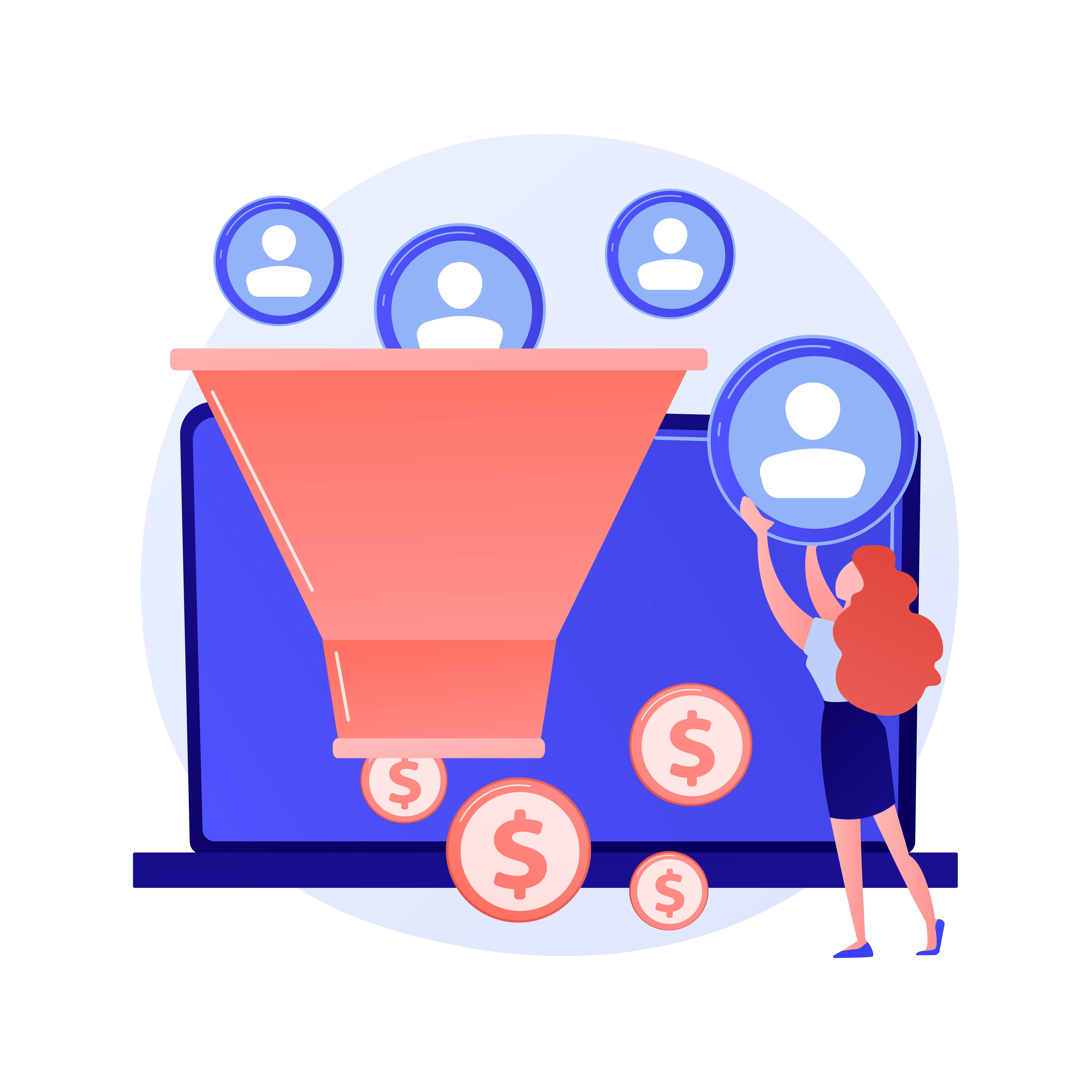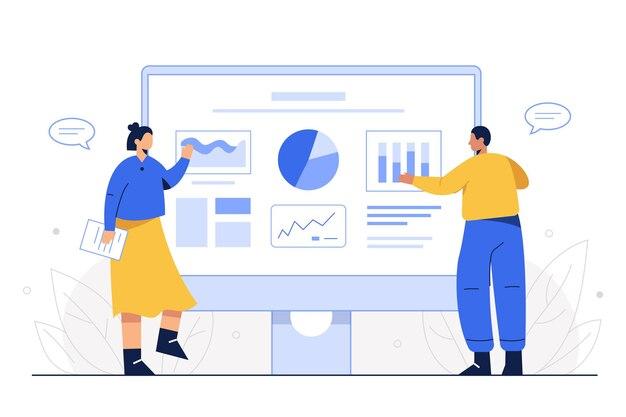All of your marketing-qualified leads (MQLs) would seamlessly transition to sales-qualified leads (SQLs) in a perfect situation. However, you’re not likely to enjoy that kind of success without methods to qualify, score, and disqualify leads that will satisfy both marketers and salespeople. Your sales and marketing team should work together to develop a lead-gathering and sales strategy.
Each one of these actions equates to a lead. Some of them will turn into marketing qualified leads (MQLs), then sales qualified leads (SQLs), and eventually, paying customers.
But it’s never that simple, right?

The SaaS buying journey is one that’s littered with obstacles. The time between when a prospect learns about your solution to the moment they fill out a form could be weeks, even months. From there, it could be even longer until they’re exposed to enough additional touchpoints to finally agree to talk with a member of your sales team.
To complicate things further, not all MQLs are equal in terms of quality. This poses a problem for marketing teams that are primarily focused on generating MQLs.
Is MQL truly the most accurate measure of marketing value? Should SaaS marketers focus on SQL instead?
Let’s discuss.
A Marketing Qualified Lead (MQL) is a lead who has indicated an interest in what a brand has to offer based on marketing efforts or is otherwise more likely to become a customer than other leads. An MQL is judged to be interested in your products and/or services, and you may offer a solution to whatever it is they need.
An MQL has taken the first steps to become a customer and is primed to receive additional contact. From a very general perspective: marketing-qualified leads turn into sales-qualified leads (SQLs), which then turn into customers. While marketing efforts can bring leads in, the lead’s behavior is what prompts marketers to consider them an MQL.
An SQL or Sales Qualified Lead is a lead your sales team has qualified as a potential customer. SQLs are in your sales funnel, and your team is actively working to move them closer to a deal. They’re at the end of the consideration stage and are moving into the decision-making stage of their buyer’s journey where they’ll appreciate sales-focused content and support.
Typically, a sales-qualified lead is confirmed after an initial outreach call with someone on your sales team, who can determine how serious the lead is about your product, and how motivated they are to buy.
The most important difference between MQLs and SQLs is the intent to buy. While there are other factors that will affect whether a lead is categorized as marketing or sales-ready, the biggest tip-off for marketers when deciding whether or not to pass a lead on to sales is the intent to purchase. That’s a surefire sign that they’re ready to talk to sales and tells you that passing them onto sales is the best way to serve that lead.
An MQL is a lead who is downloading and converting top-of-funnel content offers. The MQLs are interested in information about your general product or services.
SQL, on the other hand, is going to download bottom-of-the-funnel content offers. SQLs are at the bottom of the funnel – they’ve already done the research, they already know they want a car, and they know which car they want. Now, they just have to figure out how to make the purchase.
A first-time visitor is a good example of a potential MQL. They’re just starting the buyer’s journey, and are working on gathering the information that will ultimately help them make a purchasing decision down the road.
A returning visitor, on the other hand, who has been to your site a few times, and is browsing key pages and downloading bottom-of-funnel content offers, is an SQL.
They like the information you’re putting out enough to keep coming back. And if they keep coming back, they’re probably ready to talk to your sales team.

Determining an MQL from an SQL is an important relationship between sales and marketing. This initial step of differentiating one from the other is the ultimate foundation for the lead hand-off.
An MQL is a lead that is more likely to become a customer compared to other leads based on lead intelligence.
Ideally, only certain forms should trigger a lead to the MQL stage, such as direct business offers and other sales-ready CTAs.
SQL is the next stage. This means that the sales team has qualified this lead as a potential customer. The SQL is in the buying cycle, while the MQL is not ready for that buying stage just yet.
Once you know what differentiates the two, you can practice lead scoring, for instance giving higher lead scores to those who visited high-value pages, filled out high-value forms, or viewed your site multiple times.
Knowing when a marketing-qualified lead has transformed into a sales-qualified lead has largely been a mystery. It’s mostly been a game of guess and test.
But some marketing and sales teams have gotten really good at it because they’ve been able to recognize some of the telltale signs – like a request for more information or a click on a call to action asking to speak with sales.
For example, even if someone asks to get on the phone with a salesperson, that doesn’t necessarily mean that this person is an SQL. This person could simply be looking for more information on a product, the specifications, or the benefits, and wondering about that information alone doesn’t necessarily mean someone is at the bottom of the sales funnel.
Marketers know that sales teams want to get involved only with qualified buyers who exhibit bottom-of-funnel activities. They want to be able to engage with prospective clients who have a budget, authority, need, and timeline. But it’s incredibly hard to differentiate those clients from incredibly active MQLs, right?
The BANT method, which stands for “budget, authority, needs, and timeline,” helps identify sales-qualified leads based on their tangible need, urgency, budget, and decision-making authority. To enhance lead qualification, AI and deep learning can be employed to analyze customer activity and pinpoint their position in the buyer’s journey. This technology uses augmented intelligence to differentiate between marketing-qualified leads (MQLs) and sales-qualified leads (SQLs) more effectively.
By understanding the buyer’s journey and qualification cycle, marketers can identify when a lead should transition from MQL to SQL, ensuring they don’t miss the optimal window. When deep learning algorithms indicate that it’s time for sales involvement, a lead can be flagged as highly qualified and ready to close, streamlining the handoff to the sales team.
To eliminate guesswork, both marketing and sales teams should collaborate on defining lead scoring metrics. Marketing automation software can be used to create a lead-scoring system that assigns values to various actions, such as website engagement, downloads, email interactions, and social media engagement. This data-driven approach helps optimize the lead qualification process and ensures timely and accurate transitions from MQL to SQL.

Your buyers have a process for buying your product or service just like how you, the seller, have a process for selling. This buyer’s process is often called the buyer’s journey. When the buying and selling processes align, everyone involved feels good about the value of the transaction and the relationship.
Handing an MQL to the sales team requires trust and careful planning. It is like passing the baton to your teammate in a relay race.
You’ve run fast and beaten your competitor, and now you are preparing to hand over your baton to your mate who is waiting for you a few meters away.
There are several ways of evaluating when an MQL becomes a sales-qualified lead and is sales-ready. Here are a few of them.
a) If a lead is visiting your website several times in a given period, this means he is more likely to be ready to buy than passive visitors. He finds the information provided meaningfully and consumes it repeatedly.
b) A marketing-qualified lead is sales-ready if he is filling out your form many times in a given period. This prospect is hot and ready to buy your stuff.
c) If Bob is arriving at the pricing page of your website, it means he is interested in buying your product. Whether the price point is okay for him is a different matter.
On the other hand, a lead that just visits your homepage and drops off is not your sales lead. At best, he is just another marketing-qualified lead.
The precise definition of SQL can vary based on what you’re offering and who you’re offering to. However, there are specific reasons that stop consumers from purchasing. Many companies are using the BANT system when qualifying leads. BANT is the abbreviation for Budget, Authority, Needs, and Timeline.
Here is a brief breakdown of how to qualify leads using the BANT system:
Ultimately, it is not about how much your prospects like your solution. If they can’t afford it, they are not qualified prospects. Selling with honesty needs the reps to determine if a prospect can really afford the solution.
If they can, you should focus on them. However, if they can’t, or if they are not sure, there is an opportunity that there are much better customers to find instead.
Imagine that you have a SaaS product and are having a telephone conversation with a prospect. The prospect is showing interest and is ready to schedule a demo. But does he have the authority to make a buying decision? Maybe yes.
Yet odds are he will have to discuss with his management before he comes to a buying decision. He may love your tool. However, he is not the only one buying it. Also, deals need buy-in from a team of decision-makers before they can close. So even with those deals with only one decision-maker, the reps have to make sure they are talking to the right decision-maker.
The golden rule is to consider whether your product or service offers value to the prospects or not. Your prospects might have several reasons not to buy your solution immediately.
For example, your product might be incompatible with a prospect’s current Salesforce infrastructure. So, prospects that don’t have Salesforce may have a need for your solution, but they cannot buy at that moment unless they start using Salesforce or your solution is compatible with their infrastructure.
You may come across many prospects for whom it’s simply not the best time to close the sale. Perhaps the prospective company is waiting to get the funding. They may choose to recruit a wider team to incorporate a specific tool. Reps need to figure out what a prospect’s timeline is before turning the prospect over to the account executive.
MQLs are the leads that aren’t in the buying mood yet, but they show they have a need you can help them with. And lead nurturing could be just the thing to turn them into more receptive buyers. Unfortunately, many companies fail to do so and consequently fail to reap the benefits that nurturing can bring.
It might take multiple visits before the opportunity ends up in your sales department. This time period is a great chance to handle objections, clarify some issues, and prove that you not only listen but also provide value.
Here’s how you can do that:
Knowing your audience and customers is at the core of what makes B2B SaaS marketing so effective and results-driven. It’s not about how much you push what you have to say; it’s about working with your customers’ needs.
If you’d like to connect with your customers and build trust emotionally, you need to design your marketing strategy around your customer’s pain points. You have to find what they value more than just the features of the product, as well as their preferred information-gathering process.
The following are a few questions that your B2B SaaS marketing team can ask:
You need to create engaging content regularly, so your leads don’t forget about you. Your content can be in any format – blogs, infographics, press releases, case studies, email chain, or downloadable resources like a whitepaper, ebook, guide, datasheet, etc. that brings value to your audience.

Here are a few examples for your B2B SaaS marketing team:
Each company will define each lead type differently. You’ll want to work with your marketing and sales teams to define each lead type based on your product or service.
It will help you craft an effective strategy that will likely lead to higher conversions. Also, it will make sure that everyone in your organization is on the same page when it comes to leads.
Before you try to convert your leads into customers, you need to understand where they are in the sales funnel. There’s no point in chasing people who aren’t interested or moving further down the sales funnel too quickly.
When someone signs up for your blog or newsletter, they’re probably new to your brand. Long-form thought leadership pieces might be the worst thing you can show them.
Use those opportunities instead to recommend tactical blog posts and helpful third-party articles.
To get that timing right, sales and marketing teams must identify the criteria that indicate readiness for the sales process and know when and how to hand off leads.
Your specific business will have unique criteria to address. However, many of the same criteria apply to all businesses.
Here are a few examples that we see many companies use to identify the ready and relevant leads for the sales process:
In some cases, only the people in certain positions will have decision-making power when it comes to making an actual purchase. For example, it’s not uncommon for employees in junior roles to do initial research. Although their role is essential and you need to engage with them, some companies may decide that a lead must be a CEO or VP level.
If you’ve done an excellent job defining your ideal customers and markets, you’ll know which verticals are the sweet spot for your product. Although there can be exceptions, it’s generally better to transfer leads to sales if the prospective company operates in one of the verticals your product serves best.
For various reasons; logistical, technical, and legal, some locations might not make sense to do business. If you’re offering a physical product, this can be even more important.
If you’re selling software, integrations or dependencies can be significant sales-readiness factors. Ensure that the integrations the prospect requires are ones that you can support.
Even if an MQL seems to meet all the other criteria, an inability to pay is a hard disqualifier. You’ve probably noticed that essentially we are using a modified BANT (Budget, Authority, Need, and Timing) approach. We are just doing it earlier to deliver better leads to sales sooner.
In general, a lead is “ready” for handoff when their interactions with your website, emails, and content are happening frequently and recently. There is a ton of nuance here, including whether the interactions are with “high intent” content or not, what constitutes engagement, and reasonable recency and frequency thresholds.
The sales team needs to be involved with helping marketing define what should be an MQL and how to hand off leads that have a higher purchase intent. Sales can even work with marketing to help develop messaging that emphasizes the use cases and functionalities that they know from experience appeal to ideal prospects.
The importance of the alignment between sales, marketing, and customer success/support cannot be overemphasized. This alignment is crucial; if there’s any disconnect between targeting, marketing qualification, and sales qualification, the entire value chain is compromised.

Separating and grading the quality of your leads ensures marketing and sales spend time where it’s most impactful. It also gives you time to target the right campaigns and messages required to nurture cooler leads before handing them off to sales.
Every time an inquiry comes in, have a method in place to determine if they’re a good fit. This will require some upfront prep work; specifically, marketing and sales should agree on objective criteria to make these decisions. An initial phone call with the right questions can then obtain the necessary information.
The best sales reps know that their role is just as much a consultant, educator, and trusted advisor as it is “selling.” With every communication, take the lead and clearly define a call-to-action or next step; don’t leave it up to the lead to follow up with you or decide what’s next.
During a phone conversation, have an objective in mind, whether that means setting up another phone call, scheduling a web demo, meeting additional decision-makers, or discussing pricing. With email communications, always include a clear call to action. Simply outlining the steps in your sales process helps move your buyer forward toward an ultimate sale.
When you do connect with a qualified lead, but they’re not ready to move forward, have a strategy to continue to nurture that potential business. Most companies stratify their leads in some way, such as A, B, or C tiers or hot, warm, and cool.
The sales team actively works “A” or hot leads to close them within a short period of time. Marketing, inside sales, or an outsourced call center, then provide a steady, planned stream of communications to stay in contact with the “B,” “C,” or warm and cool leads until the time is right.
Solid approaches for Medtech and B2B usually include sending relevant content on a regular basis, using marketing automation tools, and making periodic outbound calls to build the relationship.
Often, inbound leads come from individuals at all levels in the organization. This is especially true with inquiries from your website, events, or purchased lists. In complex B2B or Medtech sales, these professionals may be gathering information, educating themselves, or seeking ideas, without the authority to make a purchasing decision.
A first step in advancing more B2B or Medtech leads through the sales funnel is making sure you are working with a decision-maker or key influencer within the organization. While conversations with anyone in the business can be meaningful, it’s the conversations with those who feel the pain and make the decisions that are going to carry the most weight and keep things moving.
One of the biggest mistakes B2B companies make with sales leads is a one-size-fits-all process. Today, most buyers conduct detailed research online before ever contacting your company. Leads will have very different levels of understanding of your product or service and need specific follow-up information.
A marketing automation system can help customize your engagement strategy. But, even without this technology, simply taking the time to review your prospect’s interest level and clarify their needs and challenges will ensure you share the right details about your solution at the right time in the sales process. This increases the likelihood of moving a lead to the next step in your sales funnel.
How many times does your inside sales team reach out before marking a lead as dead? If it’s only one or two, it’s time to increase that number. Catching busy B2B decision-makers can routinely take 4-6 or more attempts. This doesn’t mean the lead won’t be worthwhile in the end.
Use CRM or call-tracking software to schedule follow-up calls automatically and keep lead nurturing attempts on track. Or, consider outsourcing this sales prospecting and lead nurturing work to a professional call center. Persistence does pay off.
Rather than MQL vs. SQL, businesses should adopt an MQL and SQL mentality. Marketing and sales have an equally important role to fulfill and the two lead types shouldn’t be compared against each other.
To avoid losing leads, qualification criteria must be outlined and adhered to, and leads must be smoothly handed off from marketing to sales. The better the collaboration between the two teams, the stronger the SQLs will be, and the more deals you can close.
, January 30, 2022, Team LimeCall

Top rated callback automation platform that connects your website visitors to your team within 20 seconds through phone callback and whatsapp driving upto 40% more conversions.
Learn more